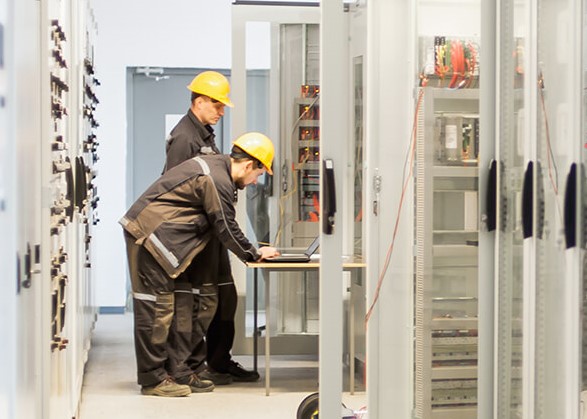DC Power Maintenance Strategies for Your Data Center
The Electric Power Research Institute (EPRI) reported that 98% of all power outages last less than 10 seconds. While a brief period of time may seem inconsequential to some, even a blip of lost power can be detrimental to critical networks. Contrary to the name, uninterruptible power supply (UPS) batteries can fail if they are not properly maintained.
In order to ensure maximum uptime and continuity in your data center, DC power systems must be kept in tip-top shape. This includes updating equipment as needed, investing in preventive maintenance, and partnering with factory-trained professionals who can avoid issues even before they emerge.
Get a Firm Grasp on Battery Maintenance Industry Standards
In the world of DC power and battery maintenance, standards and requirements are a significant component of the planning process, and for a good reason: criticality. Power interruptions have a devastating ripple effect, not only for operations, but they can also cause injuries, repairs, and fines for noncompliance.
How can your data center avoid noncompliance fines and other related issues? Start by brushing up on the industry standards below with guidance from two Vertiv gurus, Jeff Albér, VP Business Development Vertiv Battery Monitoring, and Brandon Schuler, Manager of Industrial DC Power Operations:
There are multiple industry standards used to inform and develop testing procedures, scope, and frequency of maintenance plans, including:
- The North American Electrical Reliability Corporation – NERC PRC-005
- The Institute of Electrical and Electronics Engineers – IEEE 1188, 450, and 1106
- The International Electrical Testing Association – NETA ATS-2017 and MTS-2019
See below for a brief look at each of the aforementioned standards.
NERC PRC-005
NERC PRC-005 specifies that generator owners, transmission owners, and distribution providers are required to properly maintain their power and battery backup systems as part of NERC PRC-005 compliance. The challenge utilities face is how to comply with these requirements in a cost-effective and efficient manner. The solution depends on system configuration, geographical distance between facilities, system criticality, and engineering and technical expertise.
IEEE 1188
IEEE 1188 specifies maintenance, test schedules, and testing procedures that can be used to optimize the life and performance of VRLA batteries for stationary applications. It also provides guidance to determine when batteries should be replaced.
IEEE 450
IEEE 450 specifies maintenance, test schedules, and testing procedures that can be used to optimize the life and performance of permanently installed VLA batteries. It also provides guidance to determine when batteries should be replaced.
IEEE 1106
IEEE 1106 provides recommendations for installation design, installation, maintenance, and testing procedures that can be used to optimize the life and performance of vented nickel-cadmium batteries, including partially recombinant types, used in stationary applications.
NETA ATS-2017 and MTS-2019
NETA ATS-2017 and MTS-2019 (Standard for Acceptance Testing Specifications and Standard for Maintenance Testing Specifications) specify recommended visual inspections and test intervals for batteries and battery system equipment.
Knowing the requirements is one thing, carrying them out is another. Entrust your mission-critical operations with factory-trained professionals who truly get it. We have experience working with all major brands and have the knowledge to ensure NERC and IEEE compliance for all your mission-critical functions. Contact us today to get started.
Take a Proactive Approach to DC Power Maintenance
As with most preventive maintenance plans, there are two schools of thought: Time-Based Maintenance and Performance-Based Maintenance. With the former, updates and repairs are completed based on a fixed interval of time. (This is regardless of condition or other factors). With the latter, an auditing process is used to determine the next steps at any given point, based on performance.
Both methods of maintenance have their pros and cons, so how do you choose what’s best for your facility? With support from our factory-direct Vertiv-trained engineers, you’ll be empowered with a knowledgeable guide to lead you through every step of the way. Read on for an overview, and then contact us to get started.
To reduce the likelihood of data center downtime, consider investing in preventive strategies such as:
Periodic Testing and Inspection
Your data center’s DC power system must be periodically tested for problems that could cause system failures or other issues. Make sure to inspect your equipment on a regular basis and replace any faulty parts.
Battery Maintenance
Batteries are essential to data centers, as they provide power during outages and system failures. As such, data centers should regularly monitor their batteries’ condition and replace them when needed.
Load Balancing
Ensure your data center’s load demands are evenly spread across all systems. This can help data centers maintain optimal performance levels and reduce the risk of system failure due to overloads.
Software Updates
Outdated data center software can cause slowdowns and power problems. Therefore, it’s important to keep data center applications up-to-date with the most recent software patches.
Partner with Experts
Finally, data centers should partner with factory-trained professionals who can help prevent DC power problems before they occur. Our services include quick and efficient turnkey installation services, upgrades, replacement, and life-extension services for your data center. We also provide generator preventive maintenance, battery remote monitoring, and mobile DC power services.
Take the Next Step to Protect Your DC Power
By partnering with factory-trained experts and investing in preventive maintenance strategies, data center operators can ensure that all DC power systems remain reliable, efficient, and with maximum uptime. Maintain optimal performance levels, reduce the risk of system failure due to overloads, and protect your critical networks from costly outages by contacting us today. Let’s get started.

